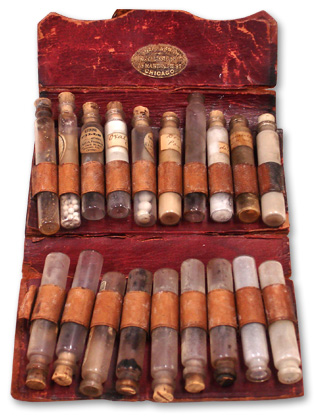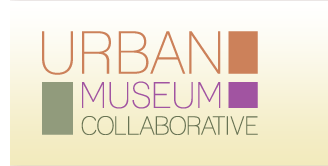
Mid-19th Century
America
Leather, glass, cork, paper, and chemical compounds
Eugene Field House Museum
Descriptive Detail
Glass vials in two neat rows line the inside of the brown leather case. Small labels on each indicate the contents within—some compounds such as ginger and quinine are familiar, others like oxalate cerium and Dover powder, less so. Stoppers of cork or glass seal the end of each vial. On close examination, a label tucked under an inside flap reads Sutcliff’s Pharmacy—Randolph Street, Chicago. Nineteen of the twenty spaces are filled. When closed, the four- by six-inch size suggests portability. Who did this belong to and why this selection of compounds?
Local Historical Connections
An example of a nineteenth century apothecary case, this is a personalized medicine cabinet, first aid kit, or a drug-store-to-go. The remedies and medications would have had been assembled and filled by a pharmacist to treat an individual’s medical conditions. Often the pharmacist or apothecary not only supplied the particular drug compound, but also gave medical advice. This case belonged to Eugene Field and was most likely assembled when he lived in Chicago. The particular compounds suggest that he might have suffered from dyspepsia, a nineteenth-century term for indigestion or upset stomach. With this medicine available, he would be able to take a small amount of the particular compound to relieve the symptoms.
National Historical Connections
Standardized medicines in capsule or pill form are a modern convenience developed primarily in the twentieth century. Cultures throughout history accumulated knowledge of the curative effects of plants and natural compounds. Literature abounds with such references from The Canterbury Tales to William Shakespeare and more. In St. Louis during the nineteenth century, remedies might be obtained from an apothecary, a physician, or a midwife. But for most inhabitants, the tradition of home remedies and self-care was the only option available. This was in many cases preferable since physicians of the time were accustomed to giving mercury and other oftentimes poisonous materials to their patients as well as bleeding them in hopes of curing an illness. Herbs grown in gardens were used to add flavor to food, but they were also used for medicinal purposes. The first settlers brought with them knowledge passed down in families, often a small amount of some plants and herbs, and the seeds to grow more. The poorer you were, the more self-reliant you needed to be. When Lewis and Clark began their journey west, they were also looking for medicinal plants to compensate for the supplies from abroad that Jefferson was afraid would dry up. The Indians they met along the way had knowledge of plants and remedies that were gradually added to the general store of knowledge. Today perhaps as much as fifty percent of all our medicines still come from plants and other natural sources.
top^
next artifact}
|

|



